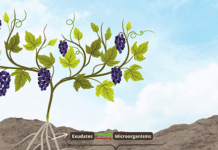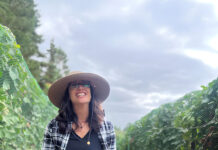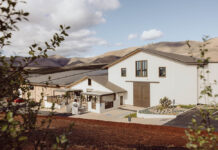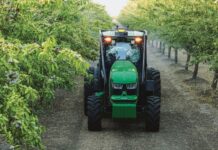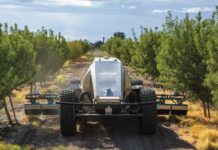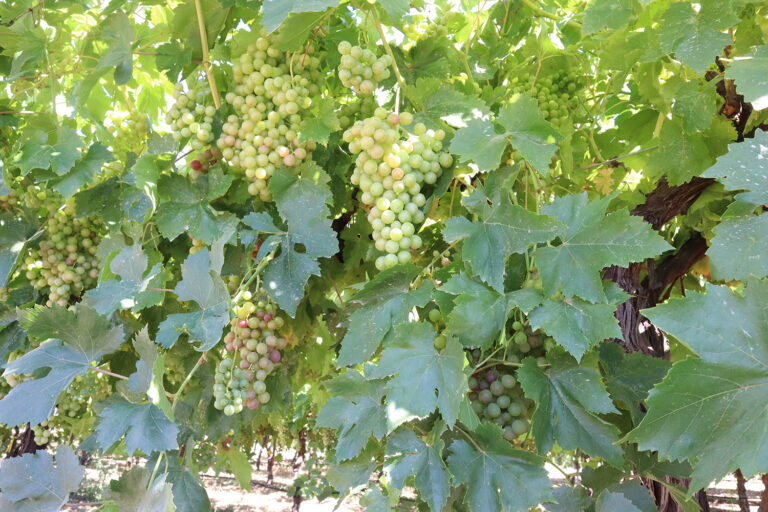
Listen to the audio version of this article (generated by A.I.)
The sulfury smell on our shirts in the spring signals a new season and the battle with powdery mildew (PM), arguably the most important and expensive disease to control in the vineyard. The causal pathogen, Erysiphe necator, has a high productive rate and short generation time. Since it infects succulent tissues of grapevines, including young shoots, green berries and rachis, preventative practices like fungicide sprays typically begin at bud break and last until veraison or even beyond. Insufficient PM management results in scars on the berry, compromising fruit quality, reducing market value and increasing risks of bunch rot during fruit ripening. Given the large canopy of vines grown in the San Joaquin Valley and favorable weather conditions for PM development, fungicide applications become a must.
Successful PM control relies on effective fungicide rotation and thorough spray coverage. In conventional vineyards, we depend heavily on sulfur and synthetic fungicides. While sulfur is affordable and resistance has not been observed, its residual effects can wear off within five to seven days, requiring frequent applications to keep the vineyard clean. Synthetic fungicides, on the other hand, convey benefits of high efficacy and long residual effects. However, their site-specific modes of action increase the risk of resistance with repeated use of the same active ingredient. Widespread resistance of FRAC 11 fungicides (QoIs) in PM has been confirmed in California vineyards, particularly in table grapes. The resistance of FRAC 3 (DMIs) is often suspected, though we still lack sensitive and reliable molecular methods to quickly confirm field observations. Note that poor spray coverage accelerates resistance development because fungi that survive the sublethal exposure have a greater chance to develop natural tolerance and genetic mutations.
In addition to sulfur and synthetic fungicides, extending beyond organic systems to conventional programs aligns with California Department of Pesticide Regulation’s sustainable pest management roadmap. Biofungicides can be roughly separated into four categories: plant extracts and oils, mineral-based oils and compounds, bacterial or fungal strains, and metabolites of fungi or bacteria. Compared to synthetic fungicides, they offer shorter reentry and preharvest intervals. They are subject to a lower risk of resistance development, owing to their diverse mechanisms. While their residual activity is generally shorter, biofungicides are ideal complementary tools in conventional programs for enhanced disease control and resistance management.
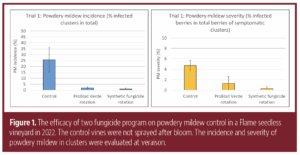
Results from Field Trials (2022-24)
From 2022 to 2024, we examined the efficacy of incorporating biofungicides into PM control in table grape vineyards. These trials involved rotating or tank-mixing biofungicides with synthetic fungicides applied between bloom and two weeks post-veraison. The efficacy of those programs was compared to a conventional synthetic program that used wettable sulfur, sulfur dust, copper and mineral oils prior to bloom, and synthetic fungicides afterward. All fungicides were used at label rates. The incidence and severity of PM in clusters were evaluated pre-veraison and at veraison.
Trial 1: Plant extract rotation
In the first trial, a plant extract-based product was integrated into a synthetic fungicide rotation. The conventional synthetic program involved pre-bloom applications of wettable sulfur followed by rotational applications of Luna Experience (fluopyram + tebuconazole), Switch (cyprodinil), Vivando (metrafenone) and Torino (cyflufenamid) every 14 days between bloom and veraison. In the other treatment, Problad Verde (Banda de Lupinus doce), a plant extract product, was applied at bloom and veraison to replace synthetic fungicides without changing the spray interval. Both programs demonstrated comparable efficacy in reducing PM incidence and severity in a Flame Seedless vineyard under moderate disease pressure (Fig. 1).
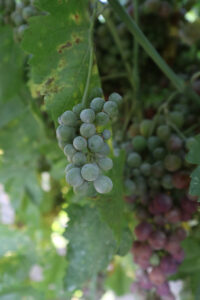
Trial 2: Bacillus-based rotation
The second trial evaluated the rotation of Bacillus-based products with synthetic fungicides. The conventional synthetic program utilized copper, sulfur and mineral oils pre-bloom, followed by a 14-day rotational schedule of Luna Experience, Switch, Vivando and Elevate 50 WDG (fenhexamid). In the other treatment, synthetic fungicides were replaced by Double Nickel (Bacillus amyloliquefaciens) and Aviv (Bacillus subtilis) at bloom, bunch closure and veraison. Considering the potentially shorter residual activity of the Bacillus products, the spray interval for this treatment was reduced to seven days (e.g., Switch applied seven days after Double Nickel at bloom). Compared to the conventional program, adding Double Nickel and Aviv to the rotation offered a small improvement in PM control (Fig. 2). It may be associated with the additional spray in the second treatment. Thus, in the second year of the experiment, we tested a similar program but kept the spray interval the same for both treatments. Results suggested comparable PM control efficacy between those two programs (Fig. 2).
Additional tank-mix trials
In two other trials, biofungicides, including Oxidate 5.0 (hydrogen peroxide and peroxyacetic acid), Cinnerate (cinnamon oil and potassium oleate) and Instill O (copper sulfate pentahydrate), along with Aviv and Double Nickel, were tank-mixed with synthetic fungicides. These tank-mix programs demonstrated comparable efficacy in reducing PM incidence and severity to the conventional synthetic program. No phytotoxicity was observed. However, these findings are preliminary. The viability of Bacillus bacteria in specific tank mixes with synthetic fungicides as well as potential phytotoxicity issues requires further investigation.
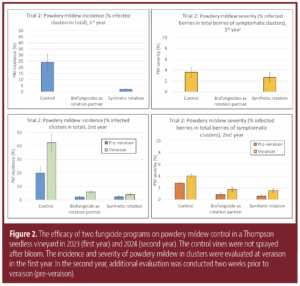
Overall, our findings suggest incorporating biofungicides into conventional fungicide programs, either through rotation or tank mixing, can achieve similar PM control efficacy as programs relying solely on synthetic fungicides post-bloom. Integrating fungicides with complementary mechanisms may offer benefits, such as reducing the risk of fungicide resistance development and providing greater flexibility in preharvest fungicide applications. We are continuing our research and looking forward to providing the industry with updated information on effective PM management strategies.
The author would like to thank Consolidated Central Valley Table Grape Pest and Disease Control District and industry collaborators for funding support.
Discussion of research findings necessitates using trade names. This does not constitute product endorsement, nor does it suggest products not listed would not be suitable for use. Some research results involve use of chemicals which are currently registered for use or may involve use which would be considered out of label. These results are reported but are not recommended by UC for use. Consult the label and use it as the basis of all recommendations.


